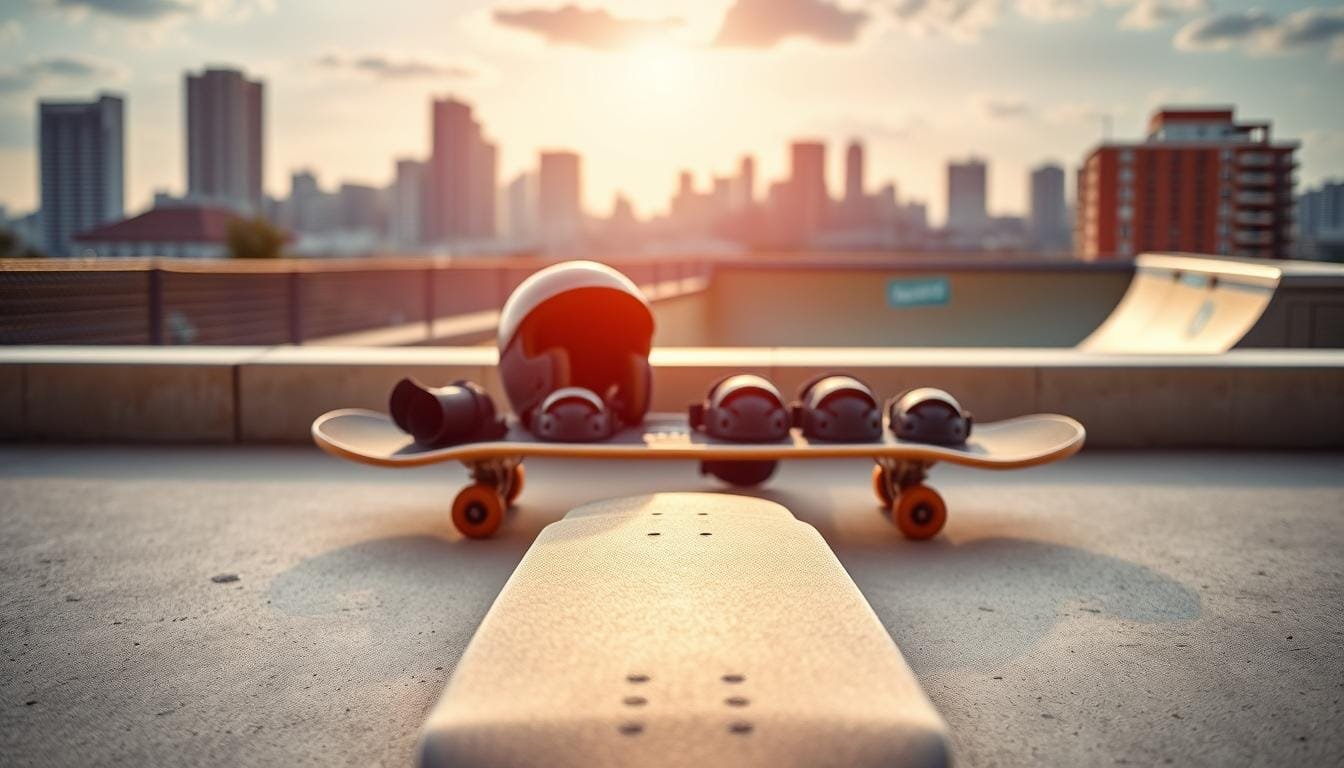Starting out in skateboarding is thrilling but a bit scary. It’s super important to pick the right gear as a newbie. This helps you learn better and stay safe. When it comes to picking your first skateboard, an 8.25 skateboard deck is a top pick for many. But, is it really good for beginners? Let’s explore why lots of experts and skaters suggest this size.
An 8.25 inch skateboard deck offers a great mix of comfort and control. This is key for anyone just starting out. If you’re over 13 and taller than 5’3”, this size fits you perfectly. Pros like Brandon Novak back this up. They say that this size is best for new skaters because it gives the right balance and versatility.
Key Takeaways
- The 8.25 inch deck is widely recommended for individuals aged 13 and older.
- It offers the perfect mix of stability and control, essential for new skaters.
- Pro skaters and experts suggest this size for its versatility in learning various skateboarding basics.
- Choosing a skateboard that matches your height, weight, and shoe size is critical for a smooth start.
- Most starter boards come pre-assembled, provide good value, and enhance the beginner’s overall experience.
Understanding Skateboard Sizes and Their Importance
Choosing the right skateboard means knowing about deck sizes. Deck width greatly affects how you skate and stay safe. It’s key to find one that feels stable and easy to control.
Your age, height, and shoe size should guide you in picking a skateboard size. Kids often go for boards between 7.00″ and 7.50″ wide. But teenagers and adults might prefer something from 7.50″ to 8.00″ wide, especially for street skating or tricks.
But there’s more to consider than just width. The length and wheelbase matter too. Typically, a 7.50″ wide board is about 31.12″ long and has a 14.00″ wheelbase. As boards get wider, both length and wheelbase adjust. This affects how nimble or stable the board feels.
| Width (inches) | Length (inches) | Wheel Base (inches) |
|---|---|---|
| 7.25″ | 29.50″ | 12.50″ |
| 7.50″ | 31.12″ | 14.00″ |
| 7.75″ | 31.12″ | 14.00″ |
| 8.00″ | 31.38″ | 14.00″ |
| 8.25″ | 32.00″ | 14.38″ |
The 8.25-inch broad skateboard is a top choice. It provides a good mix of steadiness and agility. It’s perfect for anyone, no matter if you’re just starting or have been skating for years. For newcomers, its wider top can help with balance and control.
Don’t forget to consider your shoe size too. The right board fit is vital for pulls, jumps, and tricks. Even a small change in width can alter how the board feels, all due to its shape.
Finding your ideal skateboard size is a personal journey. Try out various sizes to see what works best for you. You can also make your board unique with cool designs or graphics. And clear grip tape helps show off your style while ensuring your feet stay put.
Advantages of a 8.25 Skateboard for New Riders
For beginners, picking the right skateboard deck is key to mastering skating. An 8.25 skateboard is great for new riders. It strikes a perfect balance between being stable and easy to handle.
This deck size helps with placing your feet correctly, crucial for doing simple tricks and staying in control. It’s especially helpful for those learning at skateparks or on the streets. For extra tips, check out this beginner’s guide on skateboard purchasing.
Skateboard sizes matter and the 8.25 width is ideal for beginners. It’s the best size for learning and doing harder tricks later. Below is a table comparing skateboard sizes for new skaters:
| Skateboard Width | Recommended Age | Usage |
|---|---|---|
| 7.75″ | 10 years and older | Street, Park |
| 8.0″ | 10 years and older | Street, Transition |
| 8.25″ | All ages | Street, Park, Transition |
The 8.25 size also makes moving to advanced moves easier and builds confidence. It’s a favorite among expert skaters too for its control and enough space for feet.
For a selection of 8.25 inch decks, check out this [link](https://doctorskate.com/what-is-the-best-age-to-start-skateboarding/).
How to Choose the Right Skateboard as a Beginner
Picking out your first skateboard can seem hard. But, using a detailed skateboard buying guide makes it easier. It’s important to look at the size, shape, and type of the deck. This ensures the board fits your needs.
For picking your first board, the width of the deck is key. For instance, if you wear a US 5 (EU 36.5), a deck width from 7.625″ to 8″ works well. But, for a US 9 (EU 42.5) shoe size, choose a width between 8.00″ and 8.375″. There are also sizes for young skaters, from 7.25″ to 7.5″, fitting kids 8-12 years old.
The material of the board is important too; wooden decks are better than plastic. Most skateboards have a popsicle shape that’s good for both street and park skating. Getting advice from skateboarding forums and local shops is a smart move.
It’s usually best for beginners to get complete skateboards. They come fully assembled. This saves money, sometimes up to 40% cheaper than building one. Complete skateboards are a good deal without losing out on quality.
Getting into skateboarding, remember to wear protective gear. This includes helmets, wrist guards, elbow, and knee pads. They keep you safe and help you feel more confident. For wheels, pick ones that are 52 mm to 54 mm wide and have a hardness of 96A to 101A. This combo is great for grip and lasting a long time.
Learning to skateboard is a personal journey. Finding the perfect board might need some trying out. So, be ready to change things up as you learn what you like.
Tips for Getting Started with Your 8.25 Skateboard
Starting out with an 8.25-inch skateboard is exciting. Follow these simple tips for a smooth and fun learning experience.
Make sure your skateboard is ready to go. An 8.25-inch deck offers good balance and control, perfect for beginners. These decks are strong and durable, made from layers of maple wood.
Wheel hardness is important. Choose wheels that are medium hard (90A-99A) for all surfaces. Smaller wheels, like 56mm, are best for ramps. Your skateboard’s bearings should be ABEC 5 or higher for the best ride.
Don’t forget basic maintenance. Keep the trucks tight for stability but loose enough to turn easily. Always check for wear and tear.
Start with the basics: balance, pushing off, turning, and stopping. These skills are crucial for new skaters.
Safety comes first. Wear helmets, knee and elbow pads, and wrist guards. A helmet can hugely reduce head injury risks.
It might be hard at first, but remember, even pros like Tony Hawk and Rodney Mullen had to start somewhere. They say to practice regularly and embrace falls as part of learning.
Keep practicing and find what stance works best for you. With time, your skateboarding will improve, building your confidence.
| Stance Tips | Explanation |
|---|---|
| Regular | Left foot forward, right foot pushes off. |
| Goofy | Right foot forward, left foot pushes off. |
| Mongo | Uncommon, but push with front foot and stabilize with the back foot. |
Maintenance and Care for Your Skateboard
Keeping your skateboard in good shape is key to making it last longer. It also ensures it works well every time you use it. It’s smart to regularly check your board. This way, you spot small problems before they get big. When looking after your skateboard, start with the deck. It’s usually made from 7 layers of maple wood. Look for any cracks or chips along the edges. If there’s a lot of damage, you might need to get a new deck. This keeps it strong and safe to ride on.
Don’t forget to care for the wheels and bearings too. If you’re just starting out, wheels that are 52-54 mm across are best. They should also be fairly hard, with a rating between 92A and 101A. Check the wheels often for flat spots or uneven wearing. As for bearings, which come in ratings from ABEC 1 to ABEC 9, they should spin without any hitches. If they feel rough or make noise, they might need a clean or replacement. Clean, oiled bearings mean smooth, better rides.
Then there’s the trucks of the skateboard to think about. Inside them, you’ll find bushings that can wear down. For kids under 65 kg, softer bushings under 90A work well. Adults need harder ones, depending on how much they weigh. Also, making the trucks tighter or looser can change how your board handles. Make it fit what feels right for you. And use the right tools, like skateboard-specific wrenches, for upkeep. For extra tips on skateboard care and details on inline skate wheels, check out this link. Regular upkeeping doesn’t just increase your skateboard’s lifespan. It also helps keep you safe on your board.

I’m John Peterson, a passionate skater, blogger, and lifelong enthusiast. I’ve been skating for over 9 years and have gone on to write a blog dedicated to the sport of skating and its culture. Through my blog, I strive to share my knowledge and experience of the sport with all who are interested. From beginner tips, tricks, and equipment reviews to interviews and event coverage, I cover it all. So read my blog as I explore the wonderful world of skating!

